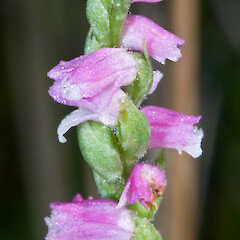Spiranthes australis
Common name
lady’s tresses, spiranthes orchid
Synonyms
Neottia sinensis Pers., Neottia australis R.Br., Spiranthes novae-zelandiae Hook.f., Spiranthes sinensis (Pers.) Ames.
Family
Orchidaceae
Flora category
Vascular – Native
Endemic taxon
Indeterminate
Endemic genus
No
Endemic family
No
Structural class
Orchids
Chromosome number
2n = 30
Current conservation status
The conservation status of all known New Zealand vascular plant taxa at the rank of species and below were reassessed in 2017 using the New Zealand Threat Classification System (NZTCS) – more information about this can be found on the NZTCS website. This report includes a statistical summary and brief notes on changes since 2012 and replaces all previous NZTCS lists for vascular plants.
Please note, threat classifications are often suggested by authors when publications fall between NZTCS assessment periods – an interim threat classification status has not been assessed by the NZTCS panel.
- Conservation status of New Zealand indigenous vascular plants, 2017 . 2018. Peter J. de Lange, Jeremy R. Rolfe, John W. Barkla, Shannel P. Courtney, Paul D. Champion, Leon R. Perrie, Sarah M. Beadel, Kerry A. Ford, Ilse Breitwieser, Ines Schönberger, Rowan Hindmarsh-Walls, Peter B. Heenan and Kate Ladley. Department of Conservation. Source: NZTCS and licensed by DOC for reuse under the Creative Commons Attribution 4.0 International licence.
2017 | At Risk – Declining | Qualifiers: DP, EF, Sp
Previous conservation statuses
2012 | Threatened – Nationally Vulnerable | Qualifiers: DP, EF, Sp
2009 | Threatened – Nationally Vulnerable | Qualifiers: DP, Sp
2004 | Not Threatened
Distribution
Endemic. New Zealand: North Island, South Island, Chatham Islands.
Habitat
Coastal to montane in open sites within wetlands of varying tropic levels but most frequently seen in acidic peat bogs. Also record from lake margins, and on the banks of slow flowing streams. Occasional in seepages within tussock grassland, or in damp shingle within river beds.
Wetland plant indicator status rating
Information derived from the revised national wetland plant list prepared to assist councils in delineating and monitoring wetlands (Clarkson et al., 2021 Manaaki Whenua – Landcare Research Contract Report LC3975 for Hawke’s Bay Regional Council). The national plant list categorises plants by the extent to which they are found in wetlands and not ‘drylands’. The indicator status ratings are OBL (obligate wetland), FACW (facultative wetland), FAC (facultative), FACU (facultative upland), and UPL (obligate upland). If you have suggestions for the Wetland Indicator Status Rating, please contact: [Enable JavaScript to view protected content]
OBL: Obligate Wetland
Almost always is a hydrophyte, rarely in uplands (non-wetlands).
Detailed description
Terrestrial, glabrescent, somewhat fleshy, perennial herb. Plant at flowering up to 1 m tall. Roots stilt-like, numerous, white, more or less swollen, clustered around stem base. Tuber broadly ovoid to ellipsoid. Stem erect, slender to stout, initially rather brittle, becoming wiry. greatly exceeding leaves. Basal leaves 2–10, obliquely erect, held in a loose basal rosette; lamina 50–200 × 5–15 mm; dark green to yellow green, often tinged reddish, narrow-elliptic, narrow-lanceolate, to lanceolate or almost spathulate tapering into a 20–100 mm long petiole; stem-bracts 2–4–(6). Inflorescence spicate. Spike 20–150 × 5–10 mm; flowers more or less crowded, subsessile, spirally around stem. Ovary glabrescent to finely glandular pubescent. Perianth 4–7 mm long, more or less tubular-cylindric, rose-pink, rose-red, red, pink or completely white. Dorsal sepal projecting forwards, column-embracing, more or less oblong, slightly concave except near the upturned apex. Lateral sepals divergent, slightly pouched at base, obtuse to subacute. Petals projected forwards, more or less oblong, more or less fused to dorsal sepal with their apices recurved. Labellum white or whitish pink with a white apex, broad and recurved at apex, more or less obscurely trilobed; mid-lobe upper margin more or less finely laciniate, much crisped, irregularly thickened; base sessile, concave, smooth, except for two prominent ovoid, lateral calli which fit beneath the stigma. Column narrow below stigma; anther obtuse, overtopping stigma; stigma broad and prominent, sometimes lacking rostellum, usually overtopped by delicate, membranous, laciniate column-wings.
Manaaki Whenua Online Interactive Key
Similar taxa
Easily recognised by the usually perennial habit; preference for growing in muddy or partially flooded sites within wetlands; tufted habit, numerous, fleshy more or less lanceolate leaves which in flowering plants are clustered around a single tall multibracteate flowering stem; and by the numerous, small, tubular dark pink, red or white flowers arranged in a compact left or right sided helix. The labellum tips are white and finely fringed.
Flowering
January–April
Flower colours
Red/Pink, White
Fruiting
April–July
Propagation technique
Should not be removed from the wild. However, rather easily grown in a peat filled pot kept partially submerged in a tub of water, or in a suitably permanently damp, peaty, sunny spot in the garden.
Threats
Extremely uncommon and has undoubtedly declined as wetland habitat has been lost and further populations within protected wetlands seem to require regular disturbance to flourish. There are now very few places where this orchid could be regarded as abundant.
Etymology
spiranthes: Spiral flower
australis: Southern
Where To Buy
Not commercially available
Cultural Use/Importance
A range of forms occur in New Zealand, one has completely white, larger flowers with widely flaring labella,and another recorded from Motutangi and the adjacent Kaimaumau Swamp seems to be insect-pollinated. The status of threse forms needs further study. Current thought is that all of these forms are best treated as one variable species S. australis.
Attribution
Description adapted from Moore and Edgar (1970).
References and further reading
Moore LB, Edgar E. 1970. Flora of New Zealand, Volume II. Indigenous Tracheophyta: Monocotyledones except Gramineae. Government Printer, Wellington, NZ. 354 p.
NZPCN Fact Sheet citation
Please cite as: de Lange, P.J. (Year at time of access): Spiranthes australis Fact Sheet (content continuously updated). New Zealand Plant Conservation Network. https://www.nzpcn.org.nz/flora/species/spiranthes-australis/ (Date website was queried)









